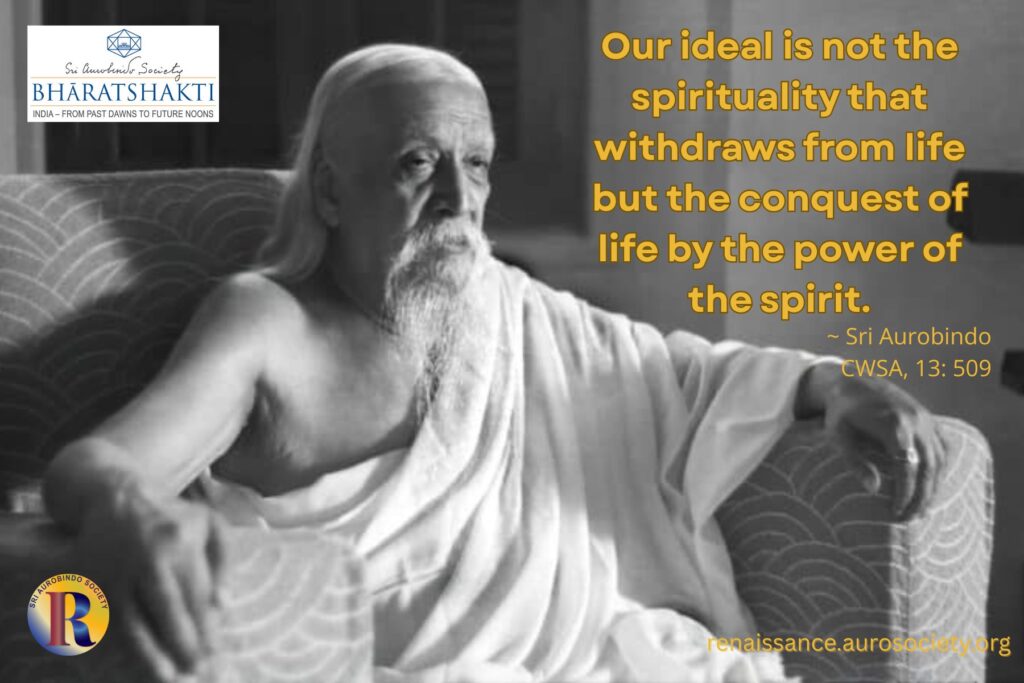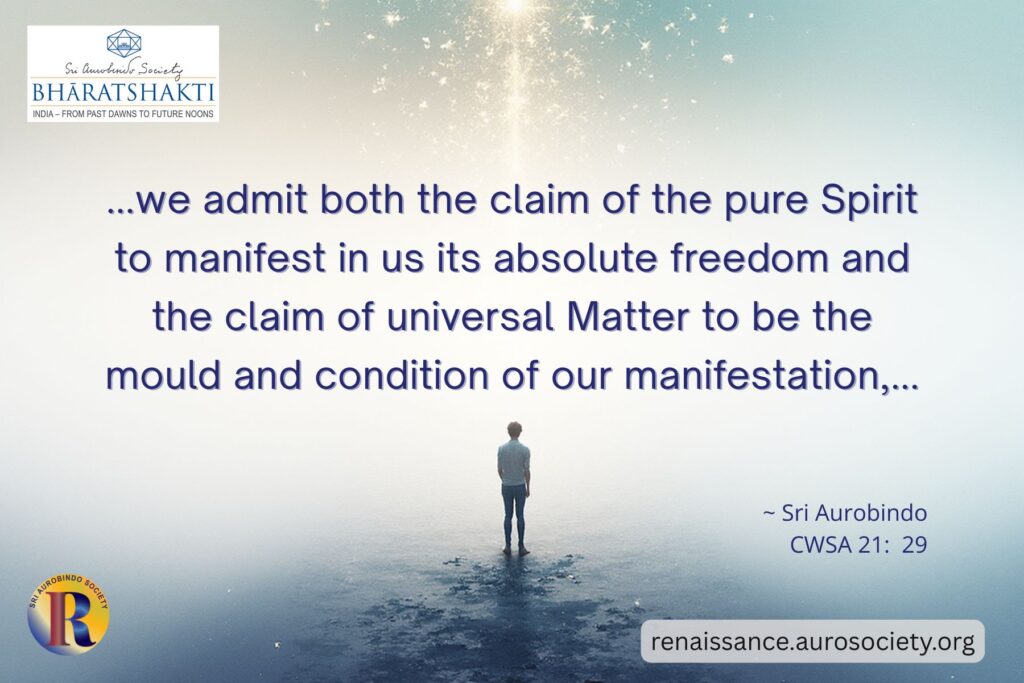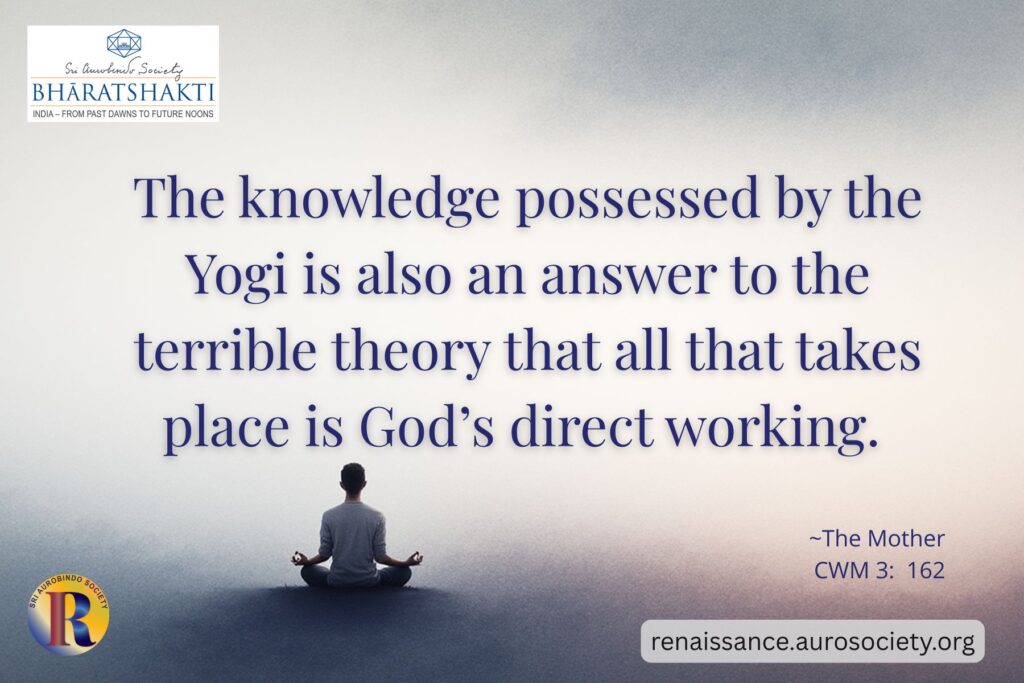Volume V, Issue 1
Author: M.S. Srinivasan
Editor’s Note: The author discusses the deeper symbolism hidden in one of the most delightful and profound aphorisms of Sri Aurobindo. Taking cues from Sri Aurobindo’s Savitri, he then speaks of the future of spiritual symbolism in poetry and other artistic expression as the human consciousness evolves further.

To commit adultery with God is the perfect experience for which the world is created.
~ Sri Aurobindo, CWSA, Vol. 12, p. 481
In this aphorism, Sri Aurobindo, with a sparkling humour, provides a luminous clue to understanding the meaning of a potent symbolism of the Vaishnava mysticism.
In most of the mystical traditions the human soul is the bride and God is the bridegroom. Hence, the union of the human soul with the Divine is a respectable bourgeois marriage. But in Vaishnava mysticism the symbolism is something radically bold and different.
Here, the husband of the human soul is not God but the World or the ordinary earthly life. The human soul is the adulterous and unchaste wife. God is not the legitimate bridegroom. But it is the clandestine divine lover and paramour with whom the human soul (like the adulterous wife) unites secretly in the nuptial chamber of the heart, unknown to the World, her husband.
In the final act, the human soul deserts her earthly husband and elopes with her divine paramour to Brindavan, the celestial abode of the divine lover.
This Vaishnava symbolism may appear revolting to the puritanical mind. But it is much more bold, revealing and expressive of the mystic path, the via mystica. However, this ideal of traditional mysticism, deserting the world and running away with God to heaven, may not be the highest or the most integral spiritual ideal.
* * *
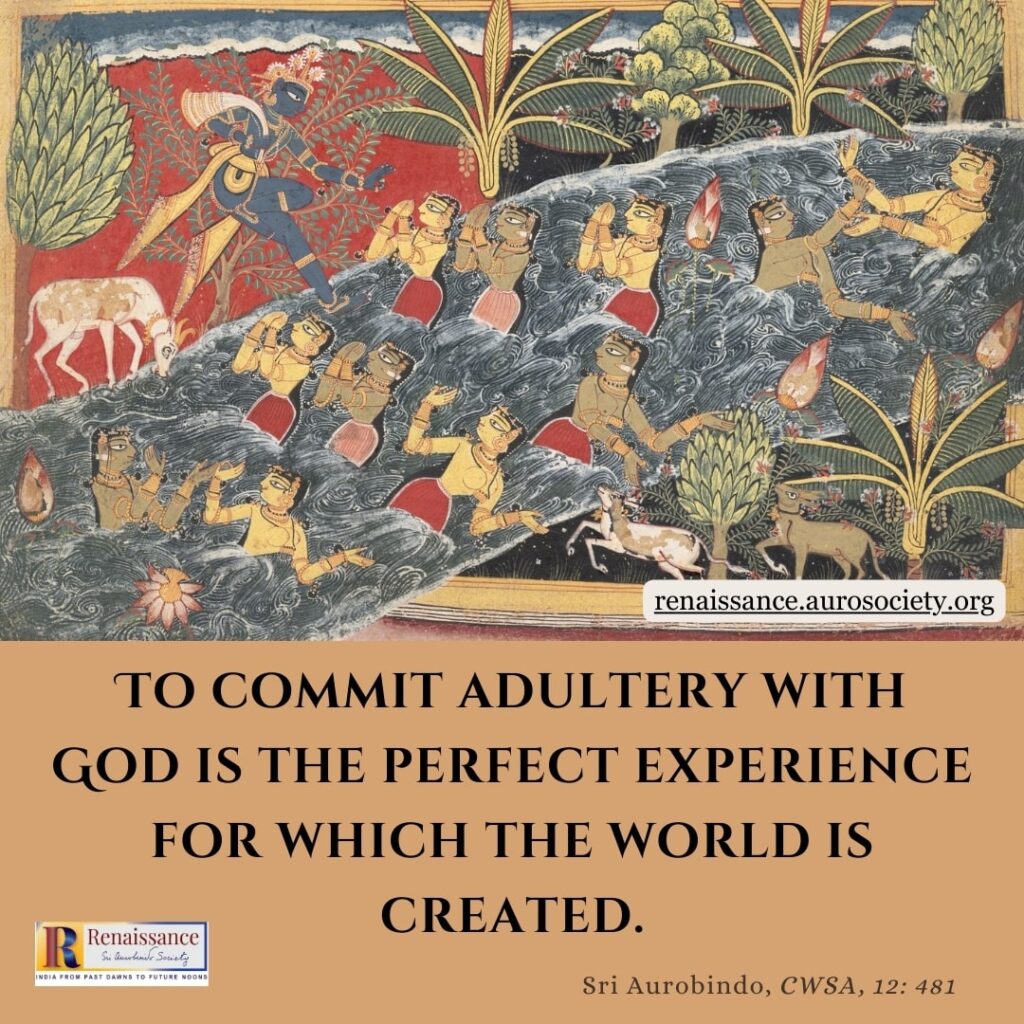
* * *
Most of the ancient mysticism was world-denying and indulged too much in secrecy, keeping the beloved divine behind a brilliant mist of riddling symbols and esoteric mysteries. Sri Aurobindo writes about these in Savitri:
And symbols hid the sense they claimed to show1
[…]By mysteries they explained a Mystery.
~ Book Two, Canto VI, The Kingdoms and Godheads of the Greater Life
A riddling answer met the riddle of things.2
Spirituality of the future will perhaps bring forward the divine lover into the open from the esoteric caves of mysticism and dungeons of religion and make the whole world his nuptial chamber and all humanity his bridge. When this happens then there will be no need for symbols.3
Symbols belong to the intermediate planes of existence and serve a purpose up to a certain stage in our spiritual evolution. But at a higher stage when we are able to see, feel, touch, live and become one with the truth of the spirit, then there is no need for symbols to understand the truth. We are still very far away from such a realisation.
But as the spiritual evolution of humanity progresses rapidly in the future, we may expect that this higher knowledge of the spirit will express itself in a less symbolic and more and more direct language. We have, as an example, the language of the Upanishads which is less symbolic than the Vedic poetry, or the spiritual poetry of Sri Aurobindo.
READ:
Of Dogs, Gods and Elements: Symbolism in the Upanishads
In Sri Aurobindo’s poetic literature we see a direct description of the various planes of cosmic existence without using symbols. For instance, Sri Aurobindo’s epic Savitri is like a cosmic and spiritual travelogue. The Traveller, particularly in Book Two, describes what he sees, feels and experiences, at various levels of cosmic existence, from the worlds of subtle matter to the highest spiritual worlds, in which, the eternal Truth lives unveiled in Her own self-existing and self-luminous light.
As the Mother said in one of her conversations,
Savitri is an exact description—not literature, not poetry (although the form is very poetical)—an exact description, step by step, paragraph by paragraph, page by page; as I read, I relived it all. . . The realism of it is astounding.
~ Agenda, Vol. 2, p. 249
As a sample, here is a description of a higher spiritual world.
All there was soul or made of sheer soul-stuff;
~ Book Two, Canto XIV, The World-Soul
A sky of soul covered a deep soul-ground.
All here was known by a spiritual sense:
Thought was not there but a knowledge near and one
Seized on all things by a moved identity,
A sympathy of self with other selves,
The touch of consciousness on consciousness
And being’s look on being with inmost gaze
And heart laid bare to heart without walls of speech
And the unanimity of seeing minds
In myriad forms luminous with the one God.4
* * *
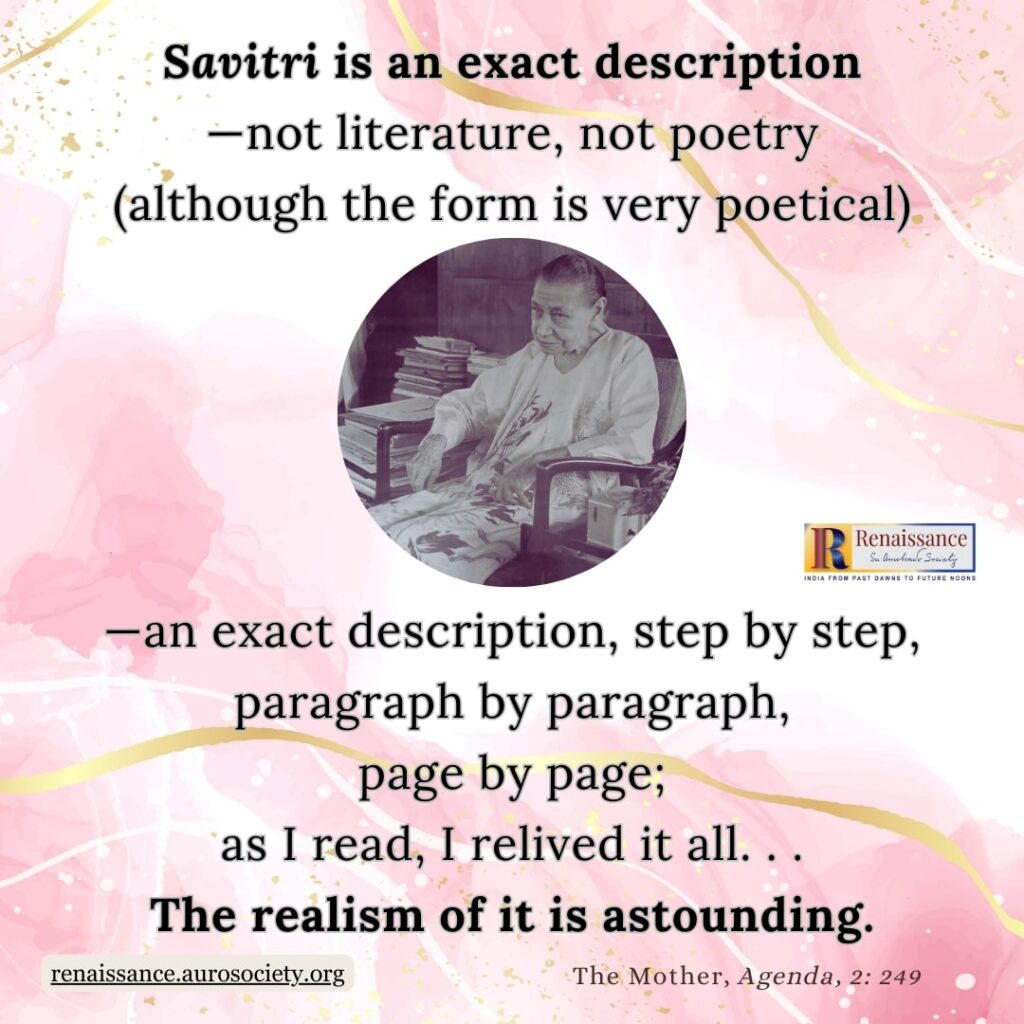
* * *
Most of the religious art and literature depicts gods in their symbolic form. But in the following passage from Savitri, Sri Aurobindo gives a more direct, exact and non-symbolic description of Gods as impersonal cosmic forces of the transcendent.
In the wide signless ether of the Self,
~ Book One, Canto IV, The Secret Knowledge
In the unchanging Silence white and nude,
Aloof, resplendent like gold dazzling suns
Veiled by the ray no mortal eye can bear,
The Spirit’s bare and absolute potencies
Burn in the solitude of the thoughts of God.
A rapture and a radiance and a hush,
Delivered from the approach of wounded hearts,
Denied to the Idea that looks at grief,
Remote from the Force that cries out in its pain,
In his inalienable bliss they live.
Immaculate in self-knowledge and self-power,
Calm they repose on the eternal Will.5
The main purpose of such a spiritual poetry of the future is not merely aesthetic amusement of the literati.
Its aim is to reproduce as perfectly and faithfully as possible within the limitations of human speech, the sound, rhythm and vibration of the inner experience and transmit it to the reader. For in the ancient Indian thought all creation is the rhythmic expression of an eternal vibration in the Absolute. Every human and cosmic experience is in its essence, part of this eternal vibration. The aim of spiritual poetry is to catch the rhythmic vibration behind the inner experience and transmit it to the reader. This is a more direct form of spiritual communication than symbolism.
But poetry and literature are only one form of expression. There are other forms of expression like painting, sculpture or architecture in which use of symbols cannot perhaps be avoided. However, a spiritual art of the future, using the modern audio-visual media, may possibly create a new form of art in which, the spiritual experiences can be presented with as much direct realism as we find in Sri Aurobindo’s poetry, along with the sensuous concreteness provided by the audio-visual media.
Notes and References
- Sri Aurobindo, Savitri, CWSA, Vol. 33, p. 175 ↩︎
- Ibid., CWSA, Vol. 33, p. 187 ↩︎
- The word ‘symbol’ is used here in its simpler sense as the imaged representation of an idea or experience and not in the broad philosophical sense in which it is sometimes used, for example, in statements like “language is a symbol” or “the whole world is a symbol of the Transcendent”. In this philosophical sense, except for the Divine who is the only Real, everything else is a symbol. ↩︎
- CWSA, Vol. 33, pp. 291-292 ↩︎
- CWSA, Vol. 33, p. 57 ↩︎

~ Design: Beloo Mehra

